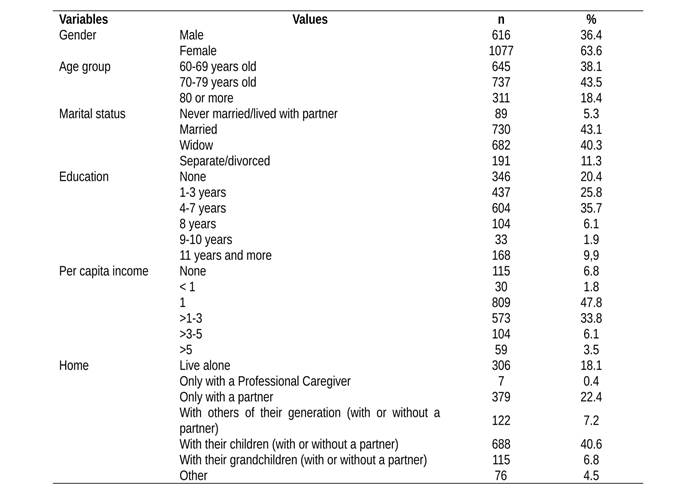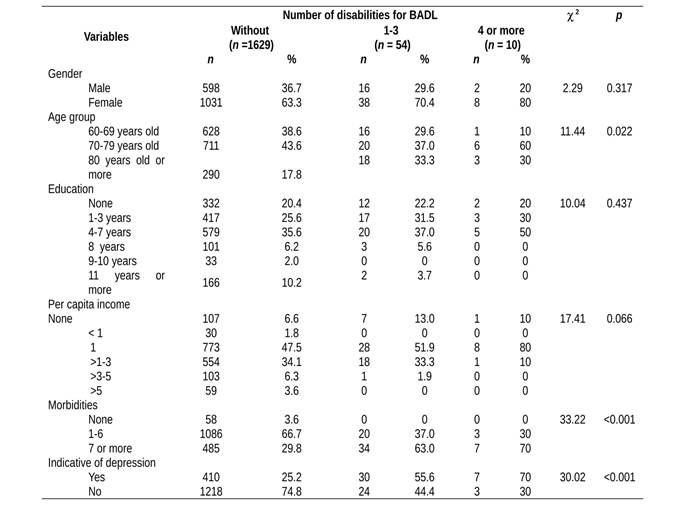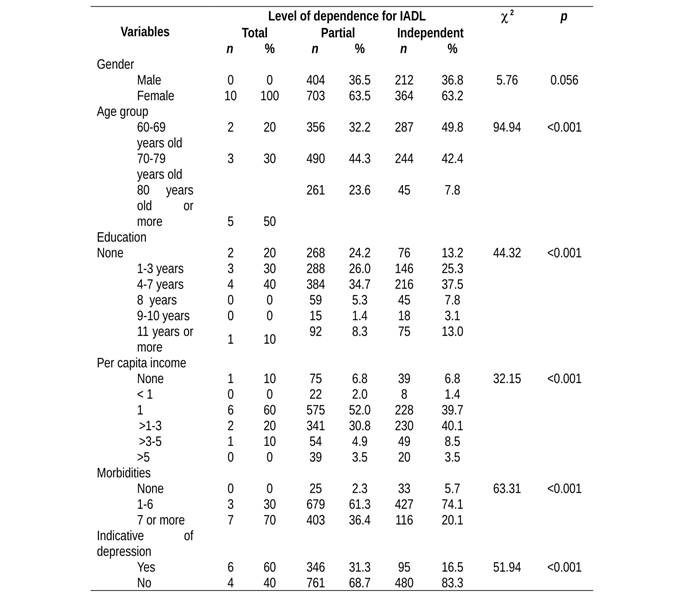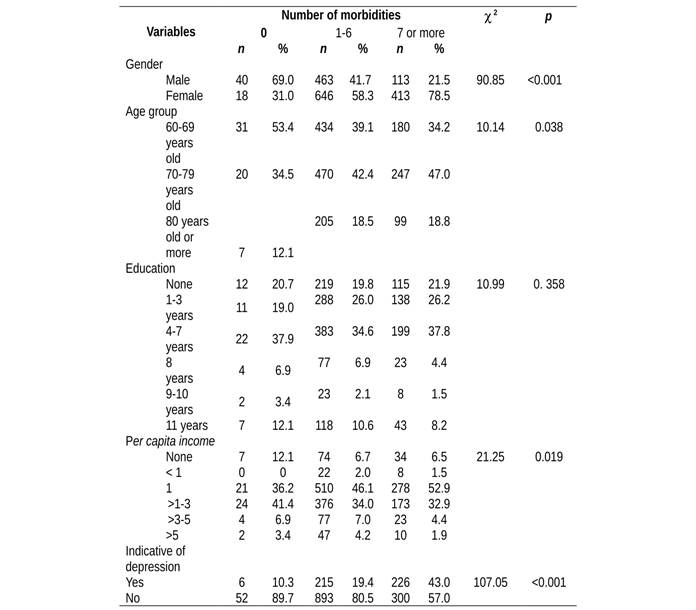Introduction
The evaluation of the functional capacity of the elderly allows the multi-professional team to have a more accurate view of the impact and severity of the diseases in the physical, emotional and social aspects.1 Thus, studies on this subject can subsidize the planning of public health policies for the elderly according to their health priorities.2 The prevalence of functional disability for basic activities (BADLs) and instrumental (IADLs) of daily life varies in national studies3-5 and international studies.6,7 As for its determinant factors, research have controversies.8-10 In a study in Bahia, functional disability in IADLs was related to income, marital status, occupation during free time, age, health problems and sequels. In the BADLs there was only the presence of health problems.8 In another national study from Minas Gerais, dependence on IADL and BADL was associated with ≥ 75 years old, the absence of a partner, a stroke, a heart disease and diabetes mellitus.5 The indication of depression has been considered a risk factor for functional incapacity in the national literature.9 In international research with elderly individuals 65 years old or older, female and older individuals were associated with functional disability for BADLs, leading to dependency. However, there was no such association for IADLs.10 In Japan, the elderly living with their children alone had a significantly greater risk of functional disability than the three-generation family group.7
It should also be pointed out that the elderly may present an unsuccessful aging, with associated comorbidities and dependence on activities of daily living (ADLs).9 Also, the literature has described that some socioeconomic conditions such as female, older and lower income are related to the greater number of morbidities.11,12 Brazilian research has shown that the low socioeconomic and cultural level are related to the development of chronic diseases.13 In an international study the female, with advanced age, worse self-perception of health and inability to access to medical care.14 However, studies in Brazil have been carried out in Family Health Strategies9,13) or with elderly people aged 65 and over,11 and there is a need for further research among those aged 60 and over in the community.
The evaluation of the functional incapacity by the nurse together with the identification of the factors associated with the non-performance of the ADLs is important to promote early interventions, favoring the maintenance of autonomy and independence of the elderly. It is a tool for planning and implementing nursing care. It is understood that nursing assessments and consultations, as well as home visits, should include questions related to the changes in functionality.1 Thus, this study aimed to verify the association between functional disability with gender, age, education, income, number of morbidities and the indicative of depression of the elderly living in the urban area to broaden the discussions on this topic, to identify the factors related to the presence of functional disability and greater number of morbidities, and to verify the association between the number of morbidities with the gender, the education, the age group, the income and the indicative of depression.
Methods
This study integrates a longitudinal study, developed by the Group of Research in Collective Health of the Federal University of the Triângulo Mineiro (UFTM) with a domiciliary survey type, and of quantitative, analytical, cross-sectional and observational approach. The sample was performed in a previous study, according to the totality of the elderly in the municipality, by the Research Center in Collective Health, considering 95% confidence, 80% of test power, margin of error of 4% for interval estimates and a proportion estimated from 0.5 to the proportions of interest, resulting in 2 892 elderly. A list was obtained to compose the sample, together with the Zoonoses Control Center of the municipality, containing the full name and address of the elderly. The choice of this place is because it maintains the updated register of all the households in Uberaba-MG. For the selection of the elderly, the stratified proportional sampling technique was used. The neighborhoods of the municipality were considered as strata. Thus, in 2012, the sample consisted of 2 118 eligible elders considering the losses in previous years. Inclusion criteria were: people aged 60 years old or older, living in the urban area of the city of Uberaba and without cognitive decline. Starting from the sample and observing the established criteria, 1,693 elderly people were interviewed, 265 died, and 160 presented a cognitive decline. Data collection was performed at the elderly household from July 2012 to March 2013 and reviewed by field supervisors.
The cognitive decline was evaluated by the Mini Mental State Examination (MMSE), translated and validated in Brazil.15,16 The socio-demographic data and morbidities self-reported by the elderly were collected in an instrument built Health Research Group. Functional capacity was performed by Index of Katz, adapted to the Brazilian reality17 and by the Lawton and Brody Scale, adapted in Brazil.18 The index of depression was measured by the Geriatric Abridged Depression Scale, validated in Brazil, with a cutoff of six or more.19 The following variables were selected: socio-demographic: gender (Male and female), age group in years (60-69, 70-79, 80 years old and over), marital status (married or living with a partner, separated/divorced; widowed and single), education in years of study (illiterate, 1-3, 4-7, 8, 9-10 and 11 or more), per capita income, in minimum wages (without income; <1; 1; >1-3; >3-5; >5); self-reported morbidities: rheumatism, arthritis/arthrosis, osteoporosis, asthma/bronchitis, tuberculosis, embolism, high blood pressure, poor circulation, heart problems, diabetes, obesity, stroke, Parkinson's disease, urinary incontinence, fecal incontinence, constipation, sleeping problems, cataracts, glaucoma, spinal problems, kidney problem, accident/trauma sequel, malignant tumors, benign tumors, vision problems; Number of morbidities: 0, 1-6, 7 or more; Functional capacity in BADLs: bathing, dressing, toilet, transfer, sphincter control, feeding; Number of functional disability for BADLs: (0, 1-3, 4 or more); Functional capacity in the IADLs: using the telephone, shopping, going to distant places, eating, housework, doing household chores, washing and ironing, taking medicines properly and taking care of finances; Classification of functional disability in IADLs: total dependence (0 to 7 points), partial dependence (8 to 20 points) and independent (21 points); Indicative of depression: yes or no.
The data collected were processed in a microcomputer, by two people, in double entry, in Excel® program. Subsequently, it was transported to the software “Statistical Package for Social Sciences” (SPSS) version 17.0, for data analysis. A descriptive statistical analysis was performed, and the chi-square test (p <0.05) was used to compare the variables. The project was approved by the Committee on Ethics in Research with Human Beings of UFTM, opinion nº 2265. Only after the consent of the interviewee and signing the Free and Informed Consent Term, the interview was conducted.
Results
There was a female elderly prevalence, aged 70-79 years old, married, living with their children, with 4-7 years of education and income of a minimum wage. Table 1 shows the socioeconomic and demographic variables of the elderly.
Table 1 Frequency distribution of the socioeconomic and demographic variables of the 1,693 elderly people. Uberaba-MG, 2014
Most of the elderly were independent for BADLs (96.2%). Among those with functional disability, 3.2% had 1-3 disabilities, and 0.6% had four and more, with those related to urinary and fecal control (2.7%) followed by bathing (1.4%) and dressing (1.4%). Independence for IADLs was reported by 33.8% of the elderly, 65.6% of whom needed partial help and 0.6% were dependent. The main disabilities were related to travel (25.5%) and housework (19%).
In the three groups, those with 70-79 years old prevailed. However, the proportion of elderly individuals aged 80 years old and over was higher among those with 1-3 and 4 and more disabilities. A higher number of morbidities and the presence of an indication of depression were associated with a greater number of functional disabilities for BADLs among the elderly.
Table 2 Number of functional disability in BADL, according to socio-demographic and economic variables, number of morbidities and indicative of depression. Uberaba-MG, 2014

Table 3 shows the level of dependence in the IADL according to socioeconomic variables, the number of morbidities and indicative of depression. In the IADLs, the highest level of dependence was higher among the elderly with 80 years old and over, lower educational level, who received a minimum wage, had seven or more morbidities and had an indicative of depression.
Table 3 Functional dependence level in the IADL according to socio-demographic and economic variables, the number of morbidities and indicative of depression. Uberaba-MG, 2014

Table 4 presents the number of morbidities according to socioeconomic variables and indicative of depression. The majority of the elderly had 1-6 morbidities (65.5%) followed by seven or more (31.1%). The elderly, female, 70-79 years old, who received a minimum wage and had an indication of depression presented more morbidities compared to the others.
Discussion
Socio-demographic and economic data are consistent with those of the national and international scientific literature.1,10,20 As for the dependence on the BADL, similar results were obtained in researches carried out in Rio Grande do Sul1 and João Pessoa20 since the findings related to the IADL are divergent of the survey conducted in Goiânia, with 14.9% of the elderly totally dependent and 45.7% needing partial help.9) Dependence may require the need for support from caregivers who need adequate preparation and help. The health services must attend to the patients in their needs, being relevant to know which are the activities of greater dependence, to the elaboration of a plan of action directed to the promotion of health, of prevention and treatment of these commitments.9 It is emphasized that it has family homes in which the elderly live with younger generations, becoming increasingly common.21 In this context, considering that the largest percentage of elderly in this study were children, with or without a partner, it is necessary to develop multi-professional interventions with a focus on strengthening this support relationship.
The association of age, morbidities, and indicative of depression with a functional disability for BADL is similar to a national finding.9 Another survey in Belo Horizonte observed higher disability percentages with increasing age.4 Considering that functional incapacity among the elderly contributes to an increase in the use of acute care services, such as outpatient, emergency and hospitalization,22 and that the presence of depressive symptoms together with the social implications.9 it is relevant to identify early cases to elaborate actions that favor the maintenance of autonomy and independence of the elderly, even with limitations. The association between age and functional disability in IADL is also consistent with a national study9. In Belo Horizonte, it was also observed higher percentages of disability as age increased.4 Regarding education, it is emphasized that the longer the study time, the greater the chances that the individual will remain autonomous despite his or her age.2
It should be noted that low income is related to a series of unfavorable conditions, which may contribute to the loss of functional autonomy. Low-income elderly individuals are more likely to have some dependency on the performance of IADL than those in the most economically disadvantaged classes.2 The presence of poly-morbidities was also related to functional disability for IADL among the elderly in João Pessoa-PB.20 Aging without planning may increase the risk of disease incidence. In this way, the prevention of comorbidities becomes paramount. From this perspective, public health policies should be directed towards the elderly. It is believed that, in this way, strategies that would increase the possibility of aging with the quality of life, improvement of autonomy and functionality may be constituted.20 The evaluation of functional capacity can contribute in this aspect by enabling nurses and other members of the health team a better view of the severity and impact of comorbidities.1 As in this study, the indicative of depression was associated with functional disability in national and international studies.12 Thus, the results obtained in this research reinforce the health professional´s need to track the indicative of depression and take the necessary actions, such as diagnostic confirmation and therapeutic establishment.
The association of the female with the greatest number of morbidities has also been reproduced in research carried out with the elderly in Brazi11 and South Africa.12 In this context, it is relevant that the nursing develops educational and preventive strategies especially focused on women. Considering their greater longevity and comorbidities, it is believed that the monitoring of their health conditions can minimize the impact on their functionality. Different from the results of this study, a survey carried out by the FIBRA Network did not observe differences between the age groups with the number of diseases11, and a study carried out in South Africa showed that the greatest number of morbidities prevailed in the age group of 60-70 years old.12
The association of low income with the greater number of morbidities was also verified in a survey conducted by the FIBRA Network.11 It is possible that the elderly with low income have less access to health services and medicines and have difficulties in maintaining treatment until the end interfering with their quality of life.11,20) Depression contributes to the elderly restriction to the domestic environment, which decreases their chances of enjoying the advantages of social interaction and it is associated with an increased risk of mortality, morbidity, physical and cognitive disability, inactivity and depression.23 It is emphasized that the functional incapacity, among other factors, that compromise the social involvement of the elderly contribute to the elderly dissatisfaction with life24 and it can justify this result. In this sense, nursing can contribute by identifying with the elderly social activities that are of interest considering their socioeconomic conditions.
Conclusion.
The functional disability for the BADLs was associated with greater age, a greater number of comorbidities and the indicative of depression. The IADLs were the largest age group, lower education, lower income, presence of a greater number of diseases and indicative of depression. The elderly with the highest number of diseases were female, 70-80 years old, with a minimum wage and an indication of depression. These results reinforce that the social inequalities and health status of the elderly may be related to functional capacity and the presence of comorbidities. In this way, the importance of periodic evaluation of the functionality and aspects related to health is highlighted, considering the factors that can impact them to maintain the independence and control of the comorbidities of the elderly as long as possible. In this context, it is highlighted that the nurse can perform such evaluations in nursing consultations. Although it is not possible to identify the cause and effect relationship between the variables, since this is a cross-sectional study, the results found a point to the need for greater attention to maintaining the functionality and morbidities of this population. The identification of factors associated with the functional disability of the elderly provides important elements for prevention and intervention measures. In this sense, it is suggested that new studies be carried out with a longitudinal design to verify the possible causal relationship between the variables.











 text in
text in 



